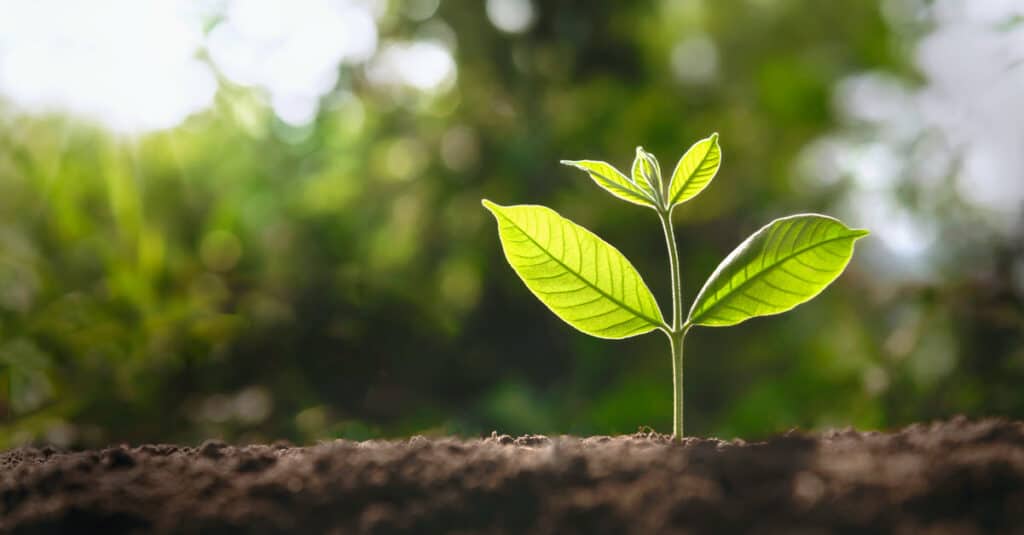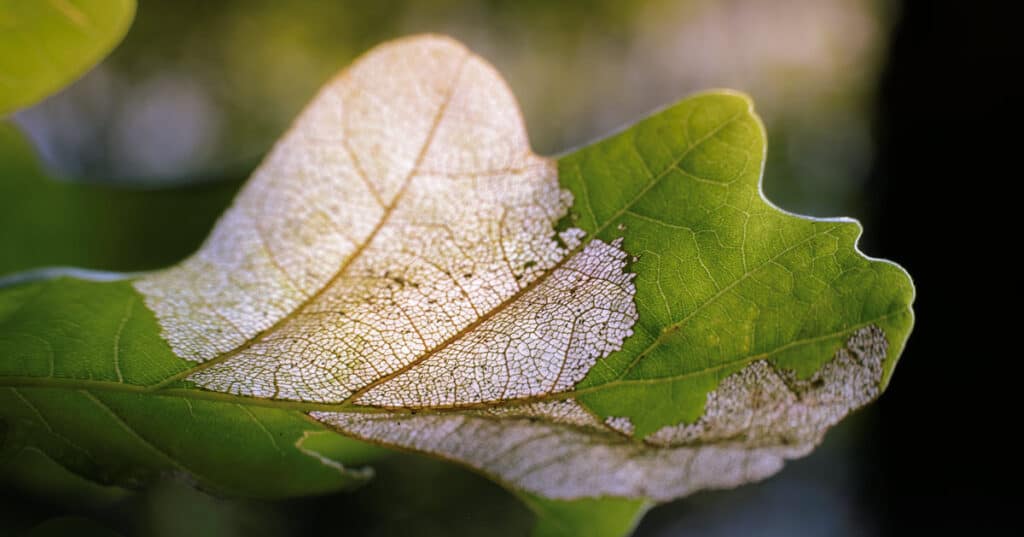Achieve a Mature Landscape in DFW More Quickly
If you purchased a new house with a barren landscape – or if you’re in a brand new house with minimal landscaping, filling out your yard by planting fast growing trees is an option.
7 Benefits of Fast Growing Trees for Dallas Texas
- Landscape Enhancement: Fast-growing trees can quickly enhance the aesthetic appeal of a property, providing lush foliage, and shade. Fruit trees are not only flowering trees, but they oftentimes provide edible fruit. They can transform a bare or unattra
- Shade and Cooling: Trees can offer significant shade, which can help to cool homes and yards, reducing the reliance on air conditioning during hot weather and potentially lowering energy costs. Shade trees can certainly put a significant dent in those electric bills by keeping your house cooler during those hot north Texas summers.
- Privacy: Sure, we all love our neighbors (except for maybe that one guy on the corner who never stops talking) but we don’t need to see them every time we’re trying to relax in our own backyard. Fast-growing trees can be used to create a natural privacy screen, blocking the view from neighbors or passersby and reducing noise pollution.
- Windbreaks: Trees can serve as windbreaks, protecting the property from strong winds, which can help to prevent damage to structures and reduce wind-chill effects during colder months. While Chicago is known as “the windy city”, Dallas (and all of North Texas) is windier on average (10.5 mph vs 9.9 mph). Our location on the Great Plains fuels the winds, and fast growing trees can provide much needed windbreaks.
- Property Value: New homeowners are usually the ones in the market for fast growing trees, but mature trees frequently help out resale value when it comes time to sell. Fast-growing species of trees can achieve this more quickly than slower-growing varieties.
- Erosion Control: Dallas receives copious amounts of rain in the spring and early fall. Trees can help prevent soil erosion by stabilizing the soil with their root systems. This can help to take the strain off of drainage systems and prevent water damage on your property. This is particularly important on slopes or in areas prone to heavy rains.
- Tree Replacement: Dallas experiences a very high number of thunderstorms annually (typically between 30 and 60). Unfortunately, older or diseased trees often succumb to severe weather. With proper tree removal and stump grinding of the fallen tree, a new, fast-growing variety of tree can quickly help to restore the lost canopy and the benefits that come with it.
7 Drawbacks of Fast Growing Trees
When it comes to fast growing trees Central Texas, the news isn’t always good. There are some definite disadvantages to selecting a fast growing tree when compared to its slower growing cousins. The temptation is to get a fast growing tree to fill out your yard, but there is a tradeoff. Fast growth comes at the expense of the durability and lifespan of the tree.
- Weak Wood Structure: Fast-growing trees tend to have softer, less dense wood, which can be more prone to breaking and damage during storms, heavy snow, ice, or high winds. While we don’t have a lot of snow and ice in north Texas, it occurs often enough over the lifespan of a tree to do some real damage. This can pose a risk to property and safety, as well as the long-term health of the tree. You’re much more likely to need a tree removal service to remove a fast growing tree than you are for a more slowly growing tree with more dense, sturdy wood.
- Shorter Lifespan: Many fast-growing trees have a shorter lifespan compared to slower-growing species. They may live for only a few decades, which can be a disadvantage if a long-term landscape feature is desired. A big part of this shorter lifespan is due to less dense, less durable wood. While proper tree care can help to extend their lifespan, they generally won’t live as long as slower growing trees.
- Increased Maintenance: A fast growing tree usually means more work for you (or your tree service). The rapid growth of these trees can lead to more frequent tree pruning and tree trimming to manage their size, shape, and to remove potentially hazardous limbs. This can result in higher maintenance costs and effort over time.
- Shallow Root Systems: Fast-growing trees may develop shallow root systems that can cause problems such as lifting sidewalks, driveways, and foundations. These roots can also interfere with underground utilities and make the trees more susceptible to being uprooted in storms.
- Water Consumption: Fast growing trees are usually very thirsty trees. They frequently have high water requirements to support their rapid growth, which can be problematic in regions with water scarcity or during drought conditions. These drought like conditions are quite common in North Texas during the heart of the winter as well as the heart of the summer.
- Pest and Disease Susceptibility: Fast growers may not have the same resistance to pests and diseases as slower-growing species, which can lead to infestations and health problems that require treatment or result in the tree’s premature decline. Additionally, the susceptibility of fast growing trees to storm damage can open the door to disease and pests.
- Less Aesthetic Value Over Time: As fast-growing trees age, they may become less visually appealing due to weak branching, a ragged or irregular canopy, and the potential for dead or damaged limbs due to storm damage.
Selecting Trees for North Texas Conditions

When Making a Tree Selection, Think About Climate, Soil, Moisture, and Whether or Not the Tree is Native to North Texas
Climate Considerations
When you’re choosing trees for North Texas, you have to take our climate into account. Your selected tree must be able to tolerate hot summers, varied rain patterns, and occasional cold snaps.
Focus on drought-tolerant varieties and native tree species that flourish in the Texas USDA Hardiness zone for your part of North Texas – which will be either 7b, 8a, or 8b. The DFW area typically falls in either growing Zone 8a or 8b.
North Texas features a climate that varies from humid in the east (near Dallas) to semi-arid in the west. Regardless of whether your property is more towards the west or towards the eastern part of North Texas, you will face hot summers which necessitates that your trees be heat-tolerant.
Winters in this region tend to be mild, but can occasionally have cold snaps well below freezing – that trees must withstand. Dallas only gets an inch or two of snow on average each year, but that snow combined with sleet and freezing rain can certainly unleash quite a bit of damage on your trees.
Other Things to Think About Before Planting a Fast Growing Tree
Consider the Space Required: Envision Your Tree as a Mature, Fully Grown Tree
Before you plant trees in North Texas, consider the size and spread of the tree at maturity. Make sure the selected area allows enough space for expansion. Trees like the Live Oak can provide ample shade but require room to grow.
Match the Tree to the Soil Present in Your Yard
North Texas has a variety of soil types including: blackland prairie soils, sandy loam soils, clay loam soils and alluvial soils. Determine what type of soil is most common on your property and make sure it is a good fit for your tree.
As an example, expansive soils like blackland prairie soils have excessive expansion and shrinking and can cause problems on your property, especially if you have a tree with high water requirements. Clay loam soils can compact and may require frequent aeration to ensure water and nutrients reaches the roots of your tree.
Sun Exposure
Make sure when selecting a tree, that your tree has adequate access to sunlight. Full sun trees in particular require at least six hours of sunlight each day. Figure out the constraints of your property and what sunlight will be available to newly planted trees.
Drought Tolerance / Firewise trees
North Texas is obviously susceptible to wildfires. You can mitigate the risk by selecting trees that are “Firewise”. For example, the Eastern Red Cedar is a fast growing tree that is on our list below, but it is considered a “Plant to Avoid” due to the fact it is highly flammable.
The Root Training Method
Proponents Claim the Root Training Method Can Allow Trees to Grow Three Times Faster. A Very Interesting Video – Worth a Watch for the Perfectly Dug Round Hole
For more information, see our article on root training.
Top Fast-Growing Shade Trees for North Texas
In North Texas, you need shade trees that thrive in the heat and soil. These trees grow quickly to provide cooling shade and enhance your landscape. Below are some of the fastest growing trees that are also a good fit for North Texas homeowners.
Green Ash
Up to 10 Feet/Year Annual Growth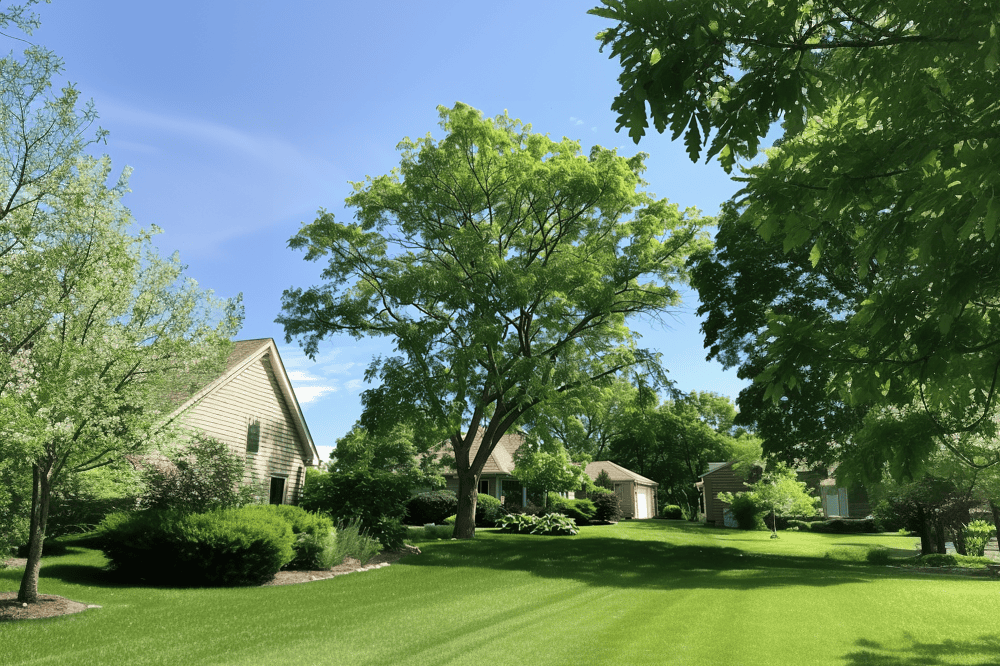
The Fast Growing Green Ash Tree in a Residential Neighborhood
Coming in at the top of our list is the Green Ash tree. With an impressive growth rate of up to 10 feet per year (wow!), the ash tree goes vertical in quite a hurry. This rapid growth makes it a popular choice for quick shade and for reforestation projects. While your growth rate may not be quite as fast, three feet of growth per year is easily achievable even in residential yards.
You’ll get plenty of shade with the Green Ash as it grows up to 60 feet in height with an impressive canopy of up to 40 feet wide.
The tree does well in moist conditions, but is also capable of growing in a variety of soil types. The green ash is known for its resilience and has been widely planted as a street tree and in urban environments due to its ability to tolerate air pollution and confined soil spaces.
The downside of the green ash is like many fast-growing trees, it may have a shorter than average lifespan. It can also be vulnerable to storm damage due to its relatively weak wood.
Unfortunately, the green ash has been severely affected by the emerald ash borer, an invasive insect pest that has killed tens of millions of ash trees across North America. The pest infestation has led to a decline in the planting of green ash and has necessitated the removal of many affected trees to slow the spread of the borer.
Emerald Ash Borer Identification
Weeping Willow
Up to 8+ Feet/Year Annual Growth
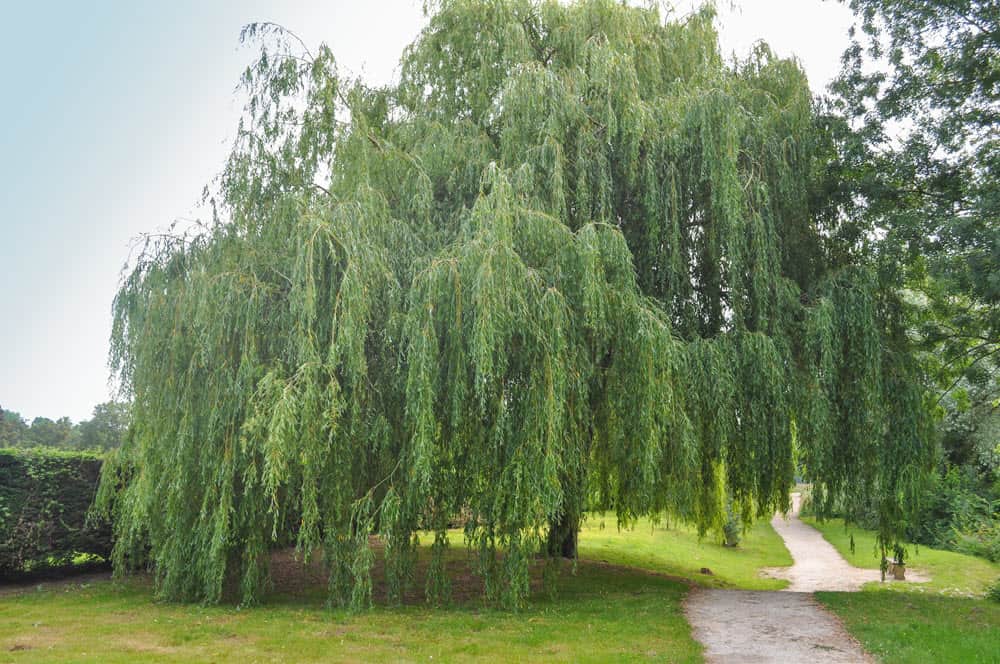
A Mature Weeping Willow
The Weeping Willow is a distinctive and elegant tree known for its long, thin, reaching branches and graceful, drooping form. While not native to North Texas (it is actually native to northern China) it does well when abundant water and proper drainage is available. Growth rates of up to 10 feet per year are not uncommon under ideal conditions. This rapid growth allows it to quickly reach its mature size and form, making it a favored choice for creating immediate landscape impact.
When fully mature, Weeping Willows typically top out anywhere from 30 to 50 feet. The canopy can be quite expansive, often spreading just as wide as the tree is tall. The broad, open canopy provides light, dappled partial shade and moves gracefully in the breeze, giving the tree its characteristic weeping appearance.
The leaves of the Weeping Willow are narrow, finely toothed, and light green, turning yellow in the fall before dropping.
A fun fact about weeping willows is that they are Weeping Willows are dioecious. This means that the trees are either male or female. They either produce pollen or flowers to aid with the reproductive process.
One drawback of these beautiful trees to keep in mind is their root system. Roots are aggressive and invasive in their quest to find water. This can cause issues if planted too close to septic systems, water lines, or foundations.
American Elm
Up to 5 Feet/Year Annual Growth

The vibrant fall colors of an Elm Tree
The growth rate of the American elm is considered to be on the very fast side with a growth rate of up to 5 feet per year. It reaches heights of up to 100 feet high and the canopy is very expansive – up to 120 feet wide. The canopy has a distinctive, spreading shape that creates a dense and overarching form, making it ideal for providing shade and aesthetic appeal. This rapid growth makes the American elm an attractive choice for those looking to quickly establish a large, shade-providing tree. The bright yellow fall color of the elm tree is also a fantastic benefit this wonderful tree provides.
Unfortunately, one of the most notable characteristics of the American elm is its susceptibility to Dutch elm disease, a fungal infection spread by elm bark beetles. The disease has been responsible for the decline of elm populations across North America. The good news is that there are many varieties of elm that are resistant to Dutch Elm disease that you can consider for you yard in Dallas.
Live Oak:
2+ Feet/Year Annual Growth
Growing live Oak Trees from Acorns (as mentioned in the video – beware of squirrels)
A relatively fast growing tree that grows up to 2-3 feet annually when young. Growth rate slows down a bit as the tree matures. The Live Oak is a sturdy tree with a large canopy that stands out in any yard. You’ll enjoy year-round shade as these oaks grow and offer sprawling canopies.
Often referred to as “evergreen trees” since they keep their leaves during most of winter, the Live Oak isn’t a true evergreen tree as it drops its leaves in the spring right before new leaves emerge to take their place.
They can reach heights of 70 feet or more, and can be even more broad than they are tall – with a canopy that can reach up to 90 feet wide. You’ll want to keep that in mind when planting a Live Oak – they will take up quite a bit of space in your yard.
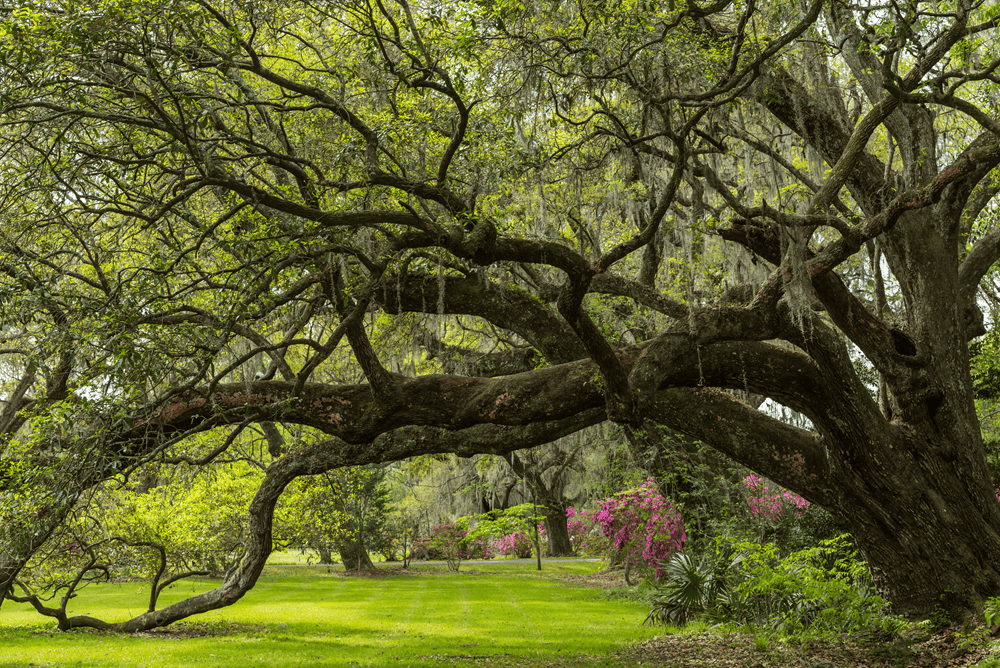
A Live Oak Tree in a large backyard – they Grow Fast and Take up a Lot of Space
Shumard Oak
2+ Feet/Year Annual Growth
The Shumard Oak is native to east Texas and is favorite deciduous tree known for its fast growth which can propel the tree to heights of 90 feet or more with a trunk diameter of up to 3-4 feet. Be sure to keep the potential size of this massive tree in mind and make sure that you have enough space for it within your yard.
The Shumard is a classic shade tree with a nice even canopy that provides ample shade. The tree does well in the loamy soils we have here in North Texas.
A great rundown of the Shumard Oak Courtesy of the University of Kentucky Forestry and Natural Resources Extension
Bald Cypress
2+ Feet/Year Annual Growth
Bald Cypress Trees Prefer Wetter Environments in North and East Texas – but the Tree Tends to do Well in Dryer Areas as Well
The growth rate of the Bald cypress is generally isn’t quite as fast as many of the other trees listed here. In ideal conditions, it can grow at a rate of about 1 to 2 feet per year, reaching 70 feet tall or even higher. The canopy is pretty impressive too – reaching anywhere from 30 feet across. It does well in the loamy soils that are common here in North Texas.
The Bald cypress is also known for its longevity and hardiness, being resistant to many pests and diseases that commonly affect other trees. Trees can live for hundreds of years, with some actually living for over 1,000 years!
This species is well-known for its unique characteristic of shedding its needles in the fall, which is unusual among conifers. The foliage turns a coppery-bronze color before dropping, which provides a striking display during fall months.
Eastern Red Cedar
2 Feet/Year Annual Growth
The Eastern red cedar is an evergreen conifer native to the eastern parts of North America including most of Texas. It is not a true cedar but is actually a member of the juniper family.
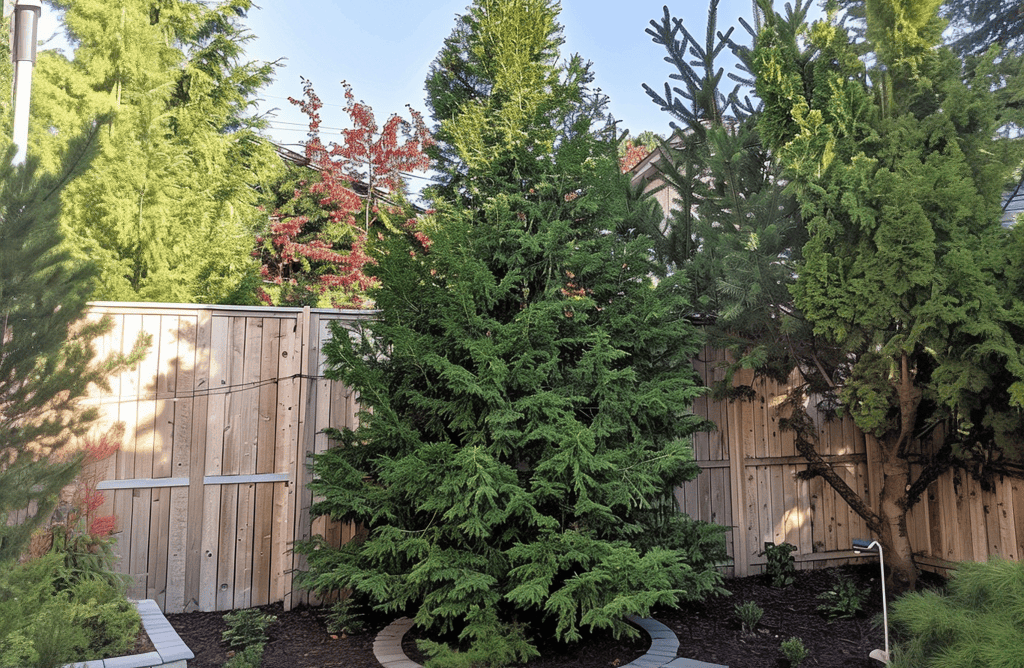
A red cedar tree in a residential backyard
The tree’s growth rate of up to 2 feet per year along with its fairly expansive canopy of up to 20 feet across makes it a good choice for homeowners in Dallas and all of North Texas. This makes them a popular choice for windbreaks, privacy screens, and ornamental plantings.
The tree has a dense, pyramidal to columnar shape when young, becoming more open and spreading with age. Its foliage consists of needle-like leaves that can be prickly to the touch, and it produces small, blueberry-like cones that are actually modified cones called juniper berries.
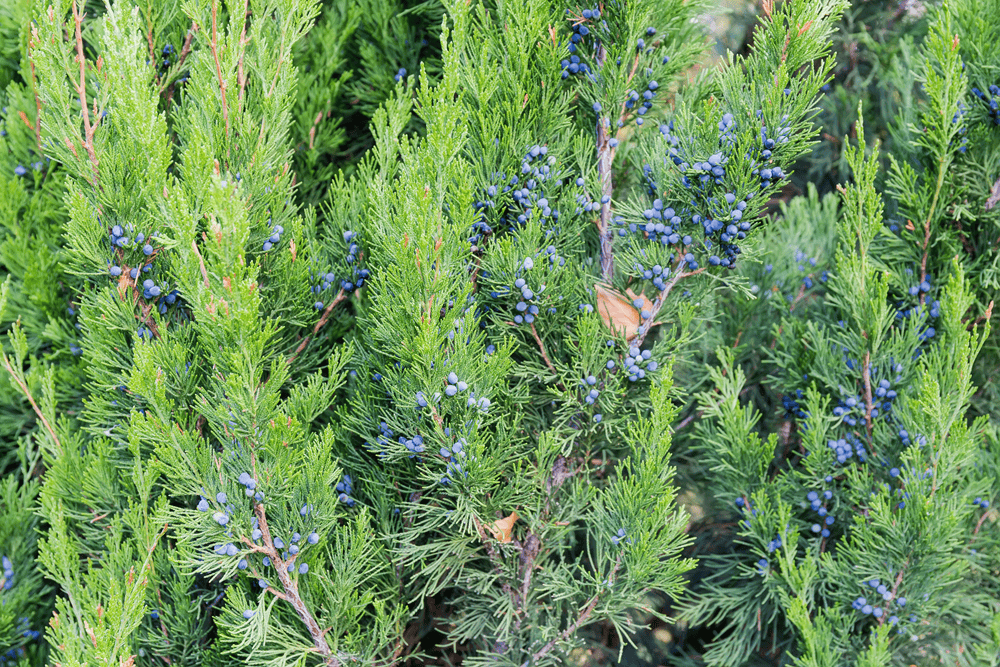
The juniper berries on a red cedar tree
This hardy tree is often found in a variety of habitats, including fields, forests, and grasslands, and is particularly adept at colonizing open, disturbed areas where it can quickly become the dominant species.
However, the tree’s volatile oils make it highly flammable, which can be a concern in fire-prone areas. Despite this, the Eastern red cedar remains a widespread and versatile tree, appreciated for its environmental and aesthetic contributions.

